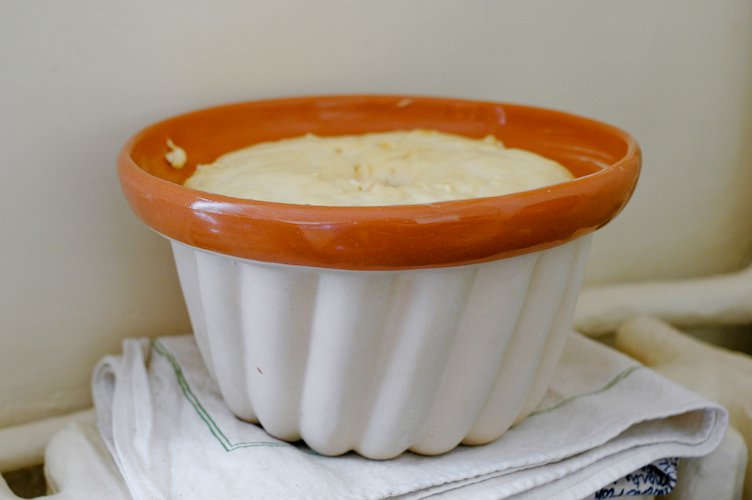Do you remember Muriel, from Muriel’s Chicken? She’s a good friend of Maxence’s mother’s who lives with her family in Le Perche, and whom we’ve been visiting every year or so with immense pleasure, and frequent sighs of contentment.
Last time we went was in the fall, and Muriel’s two lovely daughters had just started their school year; because they attend university in Paris, it means they live by themselves during the week, and come home on weekends. And in late morning on Sunday, as I was twiddling around in the kitchen, I noticed a brioche dough rising in its mold on top of the radiator. Muriel explained that this was her daughters’ weekly kouglof, which they took with them on the train and ate their way through during the week.
I thought the idea heartwarming — this is exactly the sort of thing I could see myself doing if I had daughters to send off to college — but more to the point, I had to ask: would she give me her recipe? Muriel, as I hoped she would, opened her kitchen notebook to the tattered page where she had written her own mother’s recipe, and allowed me to jot down the ingredients and instructions.
Muriel makes a weekly kouglof for her daughters, who take it with them on the train to their city apartment and eat their way through it during the week.
Kouglof, also spelled gougelhof, kougelhof, gugelhupf, kugelhof, kugelopf, or kugelhopf (dizzy yet?), is an Alsatian brioche, usually garnished with almonds and raisins, and baked in a glazed earthenware mold that gives it the shape of a crown, or a turban. Similar brioches have been baked since the Middle Ages in a large area that also comprises Austria, Luxembourg, Switzerland, Flanders, and parts of Germany, but in my heart I think of it as a specialty from Alsace and Lorraine, because that’s the sort I’ve been exposed to while on vacation there with my family.
It is on one such trip that I decided I was in urgent need of a kouglof mold of my own. In a bakery in Munster I spotted, on a high shelf behind the counter, a few really old ones that would have made me very happy — well-seasoned molds become practically non-stick* — but they weren’t for sale, so I settled for a new one, and chose the simplest model possible, an off-white mold with a caramel-colored glaze, in a shop in Colmar.
This was the summer of 2004, and I have little choice but to confess that the poor thing only gathered dust at the top of my kitchen cabinet for the four and a half subsequent years. I am a terrible person, I know. But this is a story with a happy ending, for all of a sudden, a couple of weeks ago, inspired by Muriel’s recipe and armed with a little bag of fresh yeast from the bakery, I decided to put an end to its consignment. I rolled up my sleeves and got to work.
A few hours later, I was beholding a fragrant kouglof, a moist and light-crumbed loaf I’d baked sans raisins, because raisins in brioche make me wrinkle my nose like a five-year-old. This is the perfect project for a lazy day at home — start in late morning if you want the kouglof to be ready by teatime — but, let me tell you, it is a dangerous, dangerous one for the professional procrastinator working from home.
This recipe produces a not very sweet brioche, meant to be sliced and slathered with jam, honey, or the spread of your choice. And while kouglofs are classically garnished with almonds and raisins, you can try other combos of dried fruits and nuts, such as sour cherry and pistachio. This type of brioche takes well to a subtle citrus flavoring, too, so you could add a little orange flower water, finely grated citrus zest, and/or candied citrus peel. And although you’d be taking a step further away from tradition, I can’t see the harm in a cocoa powder and chocolate chip variation.
* While looking around and reading other people’s thoughts on kouglof, I stumbled upon a post by a woman who explained that, once she’s baked enough kouglofs in a mold to season it, she gives it away to a beginner kouglof baker, and starts over with a new mold. Can you think of a more thoughtful gift?

Have you tried this? Share your pics on Instagram!
Please tag your pictures with #cnzrecipes. I'll share my favorites!
Ingredients
- 300 grams (10 1/2 ounces, see note) flour
- 50 grams (1/4 cup) sugar
- 15 grams (1/2 ounce) fresh yeast (for other types of yeast, see substitutions)
- 120 ml (1/2 cup) lukewarm milk
- 3 eggs, lightly beaten
- 1 tablespoon dark rum or kirsch
- 120 grams (1/2 cup plus 1 tablespoon) butter, at room temperature and diced, plus a good pat for the mold
- a good pinch salt (I used demi-sel butter so I skipped this)
- 35 grams (1/2 cup) sliced almonds
- 45 grams (1/3 cup) raisins and/or sultanas, soaked overnight in warm water or tea and drained
- a few whole almonds or a little more sliced almonds for the mold
- confectioner's sugar for dusting
Instructions
- Combine the flour and sugar in a large mixing bowl. In a small bowl, combine the fresh yeast with the milk and stir to soften. Form a well in the flour and pour in the milk mixture, eggs, and rum. Mix everything in with a wooden spoon.
- Mix the dough vigorously for 10 minutes, add the softened diced butter, and continue working with the dough another 10 minutes or so, until it becomes elastic. Be warned that brioche dough is very sticky; if you have a stand mixer with a dough hook, now would be a good time to use it. Add the sliced almonds and drained raisins, and mix again to combine.
- Cover the bowl with a kitchen towel and let the dough rise for 30 minutes in a warm spot of the house (I opted to place it on a kitchen towel on top of the radiator). After the first rise, punch the dough down and knead it briefly again.
- Butter the pan generously and right up to the top. Place a whole almond in each groove of the mold (or sprinkle with more sliced almonds). Pour the dough into the mold and return it to the warm spot.
- Let the dough rise to fill the mold, about 1 hour.
- Preheat the oven to 180° C (360° F) with a heat-resistant cup of water placed on the oven rack. Put the kouglof in the oven and bake for 45 minutes, until crusty and brown, and until a knife inserted in the center of the dough comes out clean. If the top seems to brown too fast, protect it with a piece of foil or parchment paper.
- Let cool completely on a rack, about 2 hours, before unmolding.
- Dust with confectioner's sugar and serve with jam, honey, or maple butter. Kouglof keeps for a few days, tightly wrapped in a clean kitchen towel ; slices can be toasted to refresh their texture. You can also freeze part or all of the loaf.



Notes
- That's 2 1/2 cups, but I encourage you to measure the flour by weight; it really is more accurate, and accuracy is especially important in yeast-based recipes such as this one.
- If your earthenware kouglof mold is brand new, you will need to prep it before the first use, otherwise it might crack. First, place it in a large bowl of warm water to which you've added half a glass of oil, and soak for 24 hours. The next day, preheat the oven to 180° C (360° F), pour a glass of milk into the (drained) mold, and bake in the oven for 30 minutes. Let cool completely, pour out the milk, and wipe before using. Kouglof molds should not be washed, but rather wiped clean with a damp towel.















